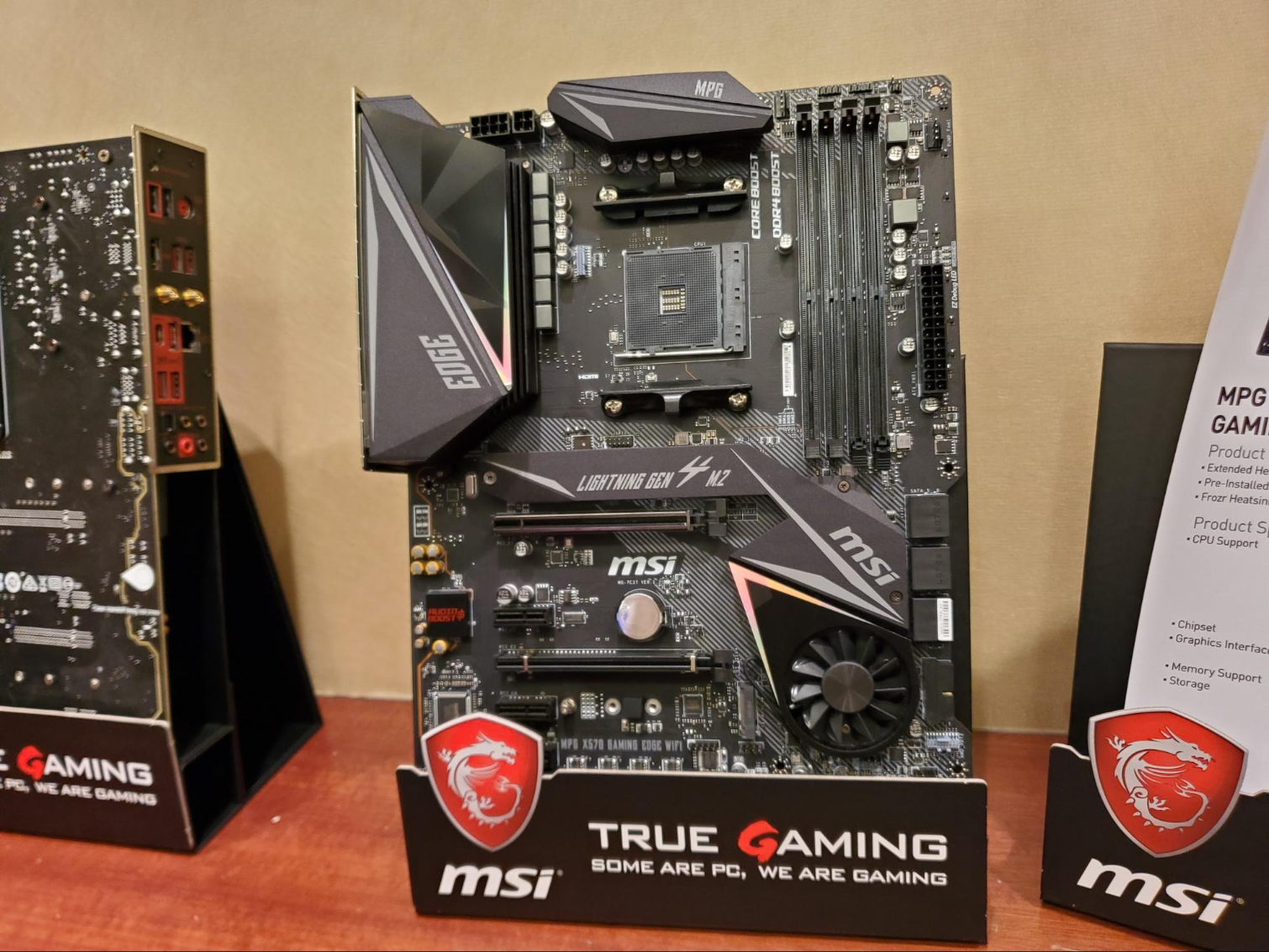Hands-On With MSI’s First X570 Motherboards: From Godlike to Gaming Plus
AMD’s Ryzen 3000 processors just got official, and with them come a slew of new motherboards. The models that MSI showed us here at Computex lean heavily into the high-end performance/content creator and gaming realms, indicating the company thinks AMD’s latest platform has some serious potential.
MEG X570 Godlike
We got some hands-on time with six MSI X570 boards, starting at the top with the MEG (MSI Enthusiast Gaming) X570 Godlike. The Godlike branding is usually reserved for high-end desktop (HEDT) platforms like X299 on the Intel side and X399 for AMD. But the lines between mainstream were already blurring thanks to Intel’s 16-thread Core i9-9900K, and Ryzen 3000 seems likely to accelerate that trend.
True to its ultra-high-end branding, the MEG X570 Godlike ships with both a 10Gb “Super LAN” Ethernet card and a PCIe Gen 4 Xpander-Z M.2 expansion card for adding two more fast M.2 drives above and beyond the three M.2 PCIe Gen 4 M.2 connectors built into the board. You also get four PCIe 4.0 x16 slots, an RGB Mystic Light Infinity II mirror over the IO shroud, and a tiny OLED screen, alongside the two-digit LCD display for error codes.
And while it remains unclear how far you’ll be able to push AMD’s new CPUs as well as memory on the new X570 chipset, this board should help you in search of those limits, thanks to its eight-layer PCB. The stepped-down MEG and Ace boards (which we’re about to get to) are six-layer boards, while stepping below that gets you a four-layer PCB.
You’re no-doubt wondering how much all of the above will cost. But the old adage “if you have to ask…” applies here. The MEG X570 Godlike’s price will make nearly all other boards seem comparatively affordable--MSI says says it’ll run about $800.
MSI Prestige X570 Creation
Stepping away from gaming for a moment, the Prestige X570 Creation is aimed at content creators and enthusiasts who need maximum connectivity. The board has dual-LAN ports, one of which is 10Gb, along with what looks to be 10 USB 3.1 Ge2 (10Gbps) ports (one Type-C).
There are still a pair of USB 2.0 ports for your don’t-need-the-speed peripherals, as well as a PS/2 combo port in case you’re still holding onto a keyboard or mouse from computing’s Cretaceous period.
Get Tom's Hardware's best news and in-depth reviews, straight to your inbox.
MEG X570 Ace
The MEG X570 Ace goes for a more subdued bronze-on-black aesthetic, but still includes an RGB Mystic Light Infinity II mirror over the IO shroud, along with a trio of M.2 connectors.
Note that the increased power draw of the X570 chipset (reportedly due in large part to the needs of the PCIe 4 interface, means than actively cooled chipsets are once again a thing. And integrated M.2 coolers (like those seen here) are going to be increasingly important if you’re opting for a super-fast next-generation PCIe 4 SSD (like the recently announced announced model from Aorus).
MPG X570 Gaming Pro Carbon WiFi
Getting back to a focus on gaming (and likely back down to a level of reasonable affordability), the MPG X570 Gaming Pro Carbon WiFi sports Wi-Fi 6 (802.11ax), Mystic Light & Sync for all your RGB dreams, a pair of PCIe 4 x16 slots, and two M.2 PCIe 4 SSD connectors.
MSI Gaming Edge WiFi
The Gaming Edge WiFi also includes wireless, but there’s no mention of a number, which likely means it’s 5/802.11ac (WiFi 5). You do, though, get a pre-installed IO shield and a heatsink that covers one of the two M.2 slots.
MPG X570 Gaming Plus
Last on the list of the boards on display at MSI’s headquarters was the MPG X570 Gaming Plus, with black-on-red aesthetics and a removable heat shield for the top M.2 connector. Note that the lower M.2 slot is not listed as supporting PCIe 4. So if you plan on installing more than one super-fast drive, you should choose one of the higher-end models with two or more ultra-fast M.2 connectors.
This board, along with the Gaming Edge WiFi, also has a recessed cutout in front of its six SATA ports and the USB 3 header, to facilitate cleaner and easier drive cabling. That’s a nice design touch considering these are by no means high-end board options.
Note that all of these boards support 2nd and 3rd Gen Ryzen processors, including those with integrated graphics like the Ryzen 5 2400G. Full specs and pricing details weren’t yet available when we wrote this. But once we know more on that front, we'll update this story.
After a rough start with the Mattel Aquarius as a child, Matt built his first PC in the late 1990s and ventured into mild PC modding in the early 2000s. He’s spent the last 15 years covering emerging technology for Smithsonian, Popular Science, and Consumer Reports, while testing components and PCs for Computer Shopper, PCMag and Digital Trends.
-
fry178 The fact that the sub 200$ gaming plus doesn't have two m2 slots @PCIe 4 is virtually irrelevant.Reply
No one that reads in forums about components (for DIY rigs) buys two of the newest and fastes (and fairly expensive) drives, and puts it on a entry/mid level board.
Evem lot less likely than someone buying a i9 to run a gtx1060,
which i havent come across so far (work/forums etc).
The ppl that actually do, deserve the (performance) penalty..







